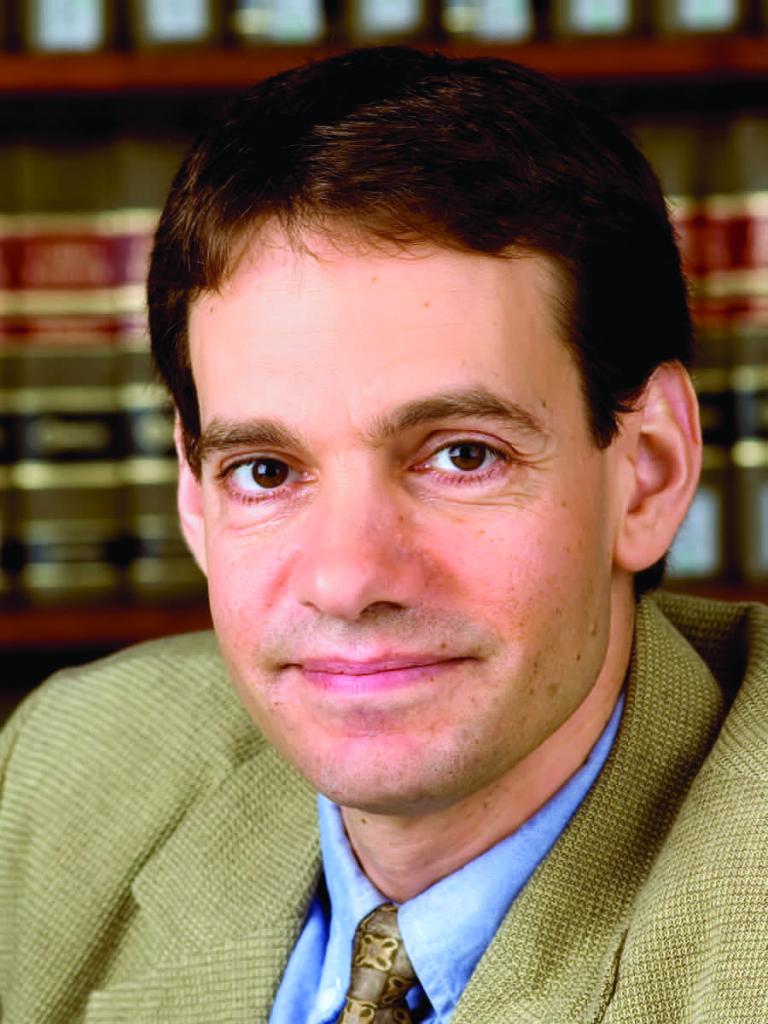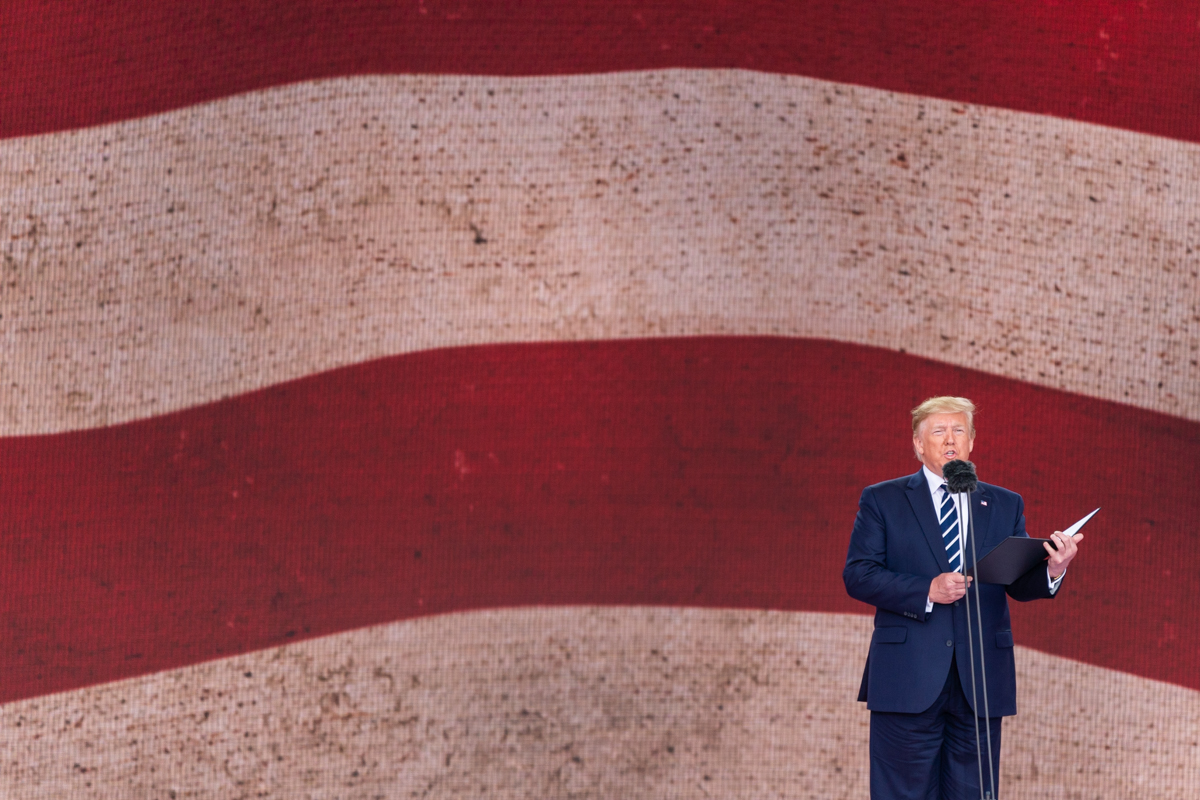Trump’s Corrupt Use of the Pardon Power
“When the whole thing is over, things might get cleaned up with some presidential pardons.” Thus did Trump spokesman Rudy Giuliani suggest—in response to the recent jailing of former Trump campaign chairman Paul Manafort for witness tampering while out on bail and reports that Michael Cohen might be willing to cooperate with Special Counsel Robert Mueller's investigation—that the president could wave his pardon wand to make all his legal troubles disappear.

Published by The Lawfare Institute
in Cooperation With

“When the whole thing is over, things might get cleaned up with some presidential pardons.” Thus did Trump spokesman Rudy Giuliani suggest—in response to the recent jailing of former Trump campaign chairman Paul Manafort for witness tampering while out on bail and reports that Michael Cohen might be willing to cooperate with Special Counsel Robert Mueller's investigation—that the president could wave his pardon wand to make all his legal troubles disappear.
The suggestion that such a corrupt use of the pardon power would be minor housekeeping for the president—just a little clean-up job—is shocking. In the Trump administration, however, it come as little surprise.
In no aspect of his presidency has Trump acted more immorally and done more damage to the rule of law and constitutional norms than in his exercise of the pardon power. He has granted only five pardons, and the immediate practical consequences of these pardons have been modest relative to the havoc he has wreaked with other endeavors—for example, his all-out assault on federal law enforcement institutions. But his pardons violate core principles of justice and appear designed to settle scores with enemies and to encourage allies to resist cooperation with the Mueller investigation.
At times, Trump appears almost gleeful about using the pardon power in a manner directly contrary to its purpose.
Three of his pardons—the recent surprise grant to conservative political commentator Dinesh D’Souza; the April grant to Scooter Libby, former adviser to Vice President Dick Cheney; and the pardon of Sheriff Joe Arpaio last August—involve grave abuses of presidential power. Each of these pardons was a debasement of the pardon power and an egregious affront to constitutional norms and the rule of law.
I.
The pardon is an exceptional remedy but one with an important role in the justice system. In the words of Justice Oliver Wendell Holmes, "A pardon in our days is not a private act of grace from an individual happening to possess power. It is a part of the constitutional scheme."
The pardon power, then, is not a whimsical add-on but an integral feature of the criminal justice system. It has deep links to moral values—think of the biblical injunctions to temper justice with mercy and to forgive those who trespass against us. In this spirit, Alexander Hamilton wrote in Federalist 74: “The criminal code of every country partakes so much of necessary severity, that without an easy access to exceptions in favor of unfortunate guilt, justice would wear a countenance too sanguinary and cruel.” The use of the pardon power should be guided by society’s highest aspirations of justice, mercy and forgiveness.
At the same time, there is potential for serious conflict between the pardon power and the justice system. This conflict is both substantive and procedural. On the substantive side, the conflict reflects an underlying tension between justice, on the one hand, and mercy and forgiveness on the other. It is commonly said that justice should be tempered with mercy, but there is a puzzle about how it could ever be virtuous to fail to do what justice requires. Mercy involves giving less punishment than justice demands. How can this not be a violation of justice? And forgiveness brings its own tension: It involves recognizing the culpable wrongness of the recipient’s conduct but nevertheless absolving the person of guilt and no longer holding him or her responsible for the wrongdoing.
On the procedural side, the judicial system has a raft of procedures and procedural protections, including the grand jury, trial by jury with right of cross-examination, appeal, the right to notice and to be heard, and the requirement that reasons be provided for decisions. Yet one person—the chief executive—can, without hearings or any process, and without even giving reasons, override or undermine charges or convictions that may be the product of years of investigation and judicial proceedings. Thus, the pardon power poses a threat to the rule of law. It is a blatant violation of justice and the rule of law, for example, for an individual to receive a pardon because one person—the president or governor—has a personal connection to the accused or wants to settle a score with a prosecutor. Indeed, in the Founders’ debates over giving the pardon power to the president, George Mason worried about the risk that a president “at some future day ... will establish a monarchy, and destroy the republic.”
For related reasons, pardons raise problems of equal treatment. Pardons, like acts of mercy, are typically regarded as discretionary acts to which no one is entitled. But it would seem to violate principles of equal treatment if one person is given a reduction in punishment when others who are similarly situated are not. And, as present events illustrate, the dangling of pardons may damage ongoing or future law enforcement efforts.
There are ways to address both the substantive and procedural conflicts between the pardon power and the justice system. Substantively, the solution is to restrict pardons to certain categories of cases in which the conflict between a pardon and the requirements of justice is absent or minimized. At a very general level, there are three broad categories of cases: those in which there was, from the start, no reason for punishment because the conviction or punishment was unjust; those in which the reasons for punishment are no longer applicable, or in which there is special reason for forgiveness; and—a more dubious category—those in which the reasons for punishment are outweighed by the public interest.
Most straightforwardly, the substantive tension is absent in cases in which the original conviction was unjust. This category includes cases of factual innocence; cases in which the defendant was convicted under an unjust statute; cases in which the statute should never have been applied to the conduct in question; cases in which the defendant was mentally impaired; cases in which the evidence was tainted; and cases in which the prosecution was improperly motivated (such as by racial animus or political rivalry).
A fine example here is Trump’s recent pardon of former heavyweight champion Jack Johnson, whose conviction under the Mann Act was vindictive and motivated by racism. Likewise, there is the pardon of Lenny Bruce (granted by then-Gov. George Pataki of New York) for convictions based on comedy routines that are now recognized as valuable social critiques.
Cases of substantive injustice are, however, peripheral to the purpose of the pardon power—in part because a pardon is widely understood to imply forgiveness of a wrongdoer, not exoneration. Indeed, an innocent person could reasonably be affronted by being offered a pardon. Accordingly, the Justice Department’s guidelines for pardons specify that a presidential pardon “is not a sign of vindication and does not connote or establish innocence” and make clear that remorse and atonement are important factors in the decision whether a pardon is warranted.
In a case of unjust conviction, moreover, the ideal solution is for the injustice to be corrected within the judicial system. A petition for habeas corpus can, for example, be used to overturn a conviction. In practice, however, the courts are resistant to revisiting convictions, and overturning a conviction is slow and difficult at best. And in certain types of cases, such as convictions under unjust statutes, judicial relief is unlikely to be available. The pardon power can therefore be a valuable relief valve in instances of unjust prosecution or conviction—and historically it has been common for prosecutors and judges to support pardon applications in such cases.
More central to the pardon power’s function are cases in which the punishment was deserved but the reasons for punishment no longer apply. These may include cases in which the defendant has expressed remorse, made amends and changed his life. An important category comprises cases in which the defendant has served his full sentence but, perhaps many years later, still is subject to the civil disabilities and other adverse consequences of a conviction. In such cases, a pardon may be used to avoid suffering that is no longer deserved.
In another kind of case, the suffering that a defendant would undergo as a result of the sentence would be disproportionate to the crime given the defendant’s specific circumstances. An elderly or gravely ill prisoner serving a short sentence for a relatively unserious crime might be pardoned on the ground that the person does not deserve to die in prison. Similarly, it is sometimes thought that a defendant who has already suffered greatly, for example by losing family, career, reputation and so on, does not deserve further suffering. Cases of a different sort present special reasons for forgiveness—for example, certain instances in which the defendant acted out of sincere, though mistaken, moral motivations.
Finally, a third and more dangerous category consists of cases in which the reasons for punishment apply but are arguably outweighed by other societal interests. Gerald Ford’s pardon of Richard Nixon might be best defended as falling into this category. Pardons of political opponents when a new regime takes power are sometimes the best way of healing national wounds and achieving reconciliation. In the aftermath of wars, rebellions and other divisive conflicts, pardons have been common in both the United States and other countries.
Pardons in this third category are especially problematic. At best, they sacrifice individual justice on the altar of a utilitarian calculus and may seem to fail to give equal respect to victims of the crime. At worst, they are quid pro quos in crass political bargains. Andrew Johnson’s controversial pardons of Confederate leaders during Reconstruction, ostensibly granted in the interest of reconciliation, were in fact motivated by partisan politics—and they were part of the background that led to Johnson’s impeachment. But perhaps when pardons are necessary to prevent lasting bitterness and to achieve reconciliation, they are justified even if unjust.
On the procedural side, the problems of capricious individual fiat and unequal treatment require procedures that give all an equal chance of being considered and that reliably identify the few applicants who are genuinely deserving. Presidential policy choices can legitimately figure in this process—examples might include the decision to forgive Vietnam War draft dodgers or those convicted of Prohibition-related crimes. Still, in order to ensure fairness and respect for the rule of law, a system must incorporate standards and procedures that routinize and channel the ultimate executive decision.
In the U.S. federal system, the Justice Department’s Office of the Pardon Attorney administers a system of rules and procedures that mitigate the conflict between the pardon power and the rule of law. (The system addresses commutations of sentences as well as pardons, and most of the points we make here apply not only to pardons but also to commutations and other acts of executive clemency.) Federal regulations, which are advisory and do not restrict the president’s pardon power, specify how pardon applications are to be made, who is eligible to apply and the like. They require that applications be given appropriate investigation, which may include notifying victims and giving them a chance to comment. In addition, the United States Attorneys’ Manual addresses the role of prosecutors in the pardon process and sets out standards for consideration of pardon applications.
The Office of the Pardon Attorney provides instructions to pardon applicants that implement the regulations. For example, an applicant is not eligible to apply for a presidential pardon until five years after his or her release (a requirement that the Department of Justice may waive). According to the instructions, the point of the five-year period is to “afford the petitioner a reasonable period of time in which to demonstrate an ability to lead a responsible, productive and law-abiding life.”
In accordance with the standards set out in the United States Attorneys’ Manual, the instructions to applicants specify that the factors relevant to pardon decisions include “the nature, seriousness and recentness of the offense, your overall criminal record, any specific hardship you may be suffering because of the conviction, and the nature and extent of your post-conviction involvement in community service, or charitable or other meritorious activities.” The instructions require applicants to provide at least three character witnesses and warn applicants “to be prepared for a detailed inquiry into your personal background and current activities.”
Probably the most critical part of the instructions is that “a pardon is granted in recognition of the applicant's acceptance of responsibility for the crime and established good conduct for a significant period of time after conviction or release from confinement.” For that reason, “when considering the merits of a pardon petition, pardon officials take into account the petitioner's acceptance of responsibility, remorse, and atonement for the offense.” (In the case of petitions based on innocence or miscarriage of justice—with respect to which acceptance of responsibility is not relevant—petitioners “bear a formidable burden of persuasion.”)
Before the Trump administration, pardons normally originated in the Office of the Pardon Attorney, which investigates each application, determines whether it meets the specified criteria and makes a recommendation to the White House. The application, with accompanying documentation, proceeds to the White House counsel’s office, where it is examined further and a recommendation is made, which finally lands on the president’s desk.
The pardon attorney and White House counsel also solicit the views of stakeholders in the justice system, especially law enforcement officials. Thus, the successive pardon applications of convicted Israeli spy Jonathan Pollard were doomed by the adamant opposition of former senior officials in the CIA and Defense Department.
II.
The pardon system is morally justifiable and consistent with the rule of law and constitutional design to the extent that it safeguards against arbitrary presidential fiat and ensures the equal application of reasons for mercy or forgiveness. Viewed through this prism, the president’s pardons of D’Souza, Libby and Arpaio are clear abuses of power that epitomize Trump’s contempt for the law and damage our criminal justice system.
Like Libby and Arpaio, D’Souza, who had pleaded guilty to making illegal campaign contributions, had not applied for a pardon. He received a call out of the blue from the president, which he initially mistook for a prank, telling him the surprising news. In this case, no one took into account “the petitioner's acceptance of responsibility, remorse, and atonement for the offense” (and no one considered whether the petitioner met the “formidable burden of persuasion” specified for miscarriage of justice petitions).
Indeed, by these criteria, D’Souza is a paradigmatic case of an undeserving applicant. Not only had he not shown remorse but he immediately waxed triumphant about the pardon, claiming that the conviction had been a “vindictive political hit”—a partisan attack by the Obama Justice Department motivated by President Obama’s anger about a movie D’Souza had made. In a display of bad taste reminiscent of Trump himself, D’Souza tweeted immediately after the pardon:
KARMA IS A BITCH DEPT: @PreetBharara wanted to destroy a fellow Indian American to advance his career. Then he got fired & I got pardoned
— Dinesh D'Souza (@DineshDSouza) May 31, 2018
He later attributed his prosecution to a “gangsterization of politics in which the organs of the state – the FBI, the Internal Revenue Service, the Justice Department and so on – are deployed against ideological adversaries.”
The main motivations for the pardon appear to have been gratitude for D’Souza’s help in promulgating a favorite Trump storyline of “deep state” corruption at the FBI, and the desire to strike at Preet Bharara, a political opponent of the president who had prosecuted D’Souza while serving as the U.S. attorney for the Southern District of New York and whom Trump later fired).
The pardon of Arpaio, the self-proclaimed “America’s Toughest Sheriff,” was another churlish swipe at the Department of Justice and, more importantly, an attack on the power of courts to enforce their own orders. The department found that Arpaio, who is widely known for condoning and engaging in police misconduct, oversaw the worst pattern of racial profiling in U.S. history. He also imposed inhumane jail conditions that resulted in a spike in inmate suicides.
The offense for which Trump pardoned Arpaio was criminal contempt of court, imposed by a federal court on a finding that Arpaio’s office was continuing to undertake illegal immigration “roundups,” based on racial profiling of Latinos, in defiance of an injunction entered by another federal court. The pardon weakened a vital judicial tool for enforcing court orders, which was probably part of its attraction for the president, who has been openly scornful of the judiciary. The pardon of Arpaio was an affront not just to the criminal law and civil rights but to the judicial system. In lawsuits challenging the pardon, some scholars have argued that this undercutting of a core judicial power calls into question the validity of the pardon.
Arpaio, moreover, possessed none of the qualifying characteristics specified by the pardon guidelines. Five years had not elapsed since his release. (In fact, Trump pardoned him while he was awaiting sentencing.) Nor did Arpaio accept responsibility or establish good conduct for a significant period of time thereafter. On the contrary, he was baldly defiant, and the pardon pointedly rewarded him for flouting the law and judicial orders.
Nor did Arpaio go through normal channels. There was no pardon application pending when Trump granted the pardon, after coyly hinting at a political rally (to wild applause) that he would do so. As far as is publicly known, no one consulted the Department of Justice, whose institutional credibility was on the line in light of its findings about Arpaio’s racial profiling and other misconduct. Indeed, Trump has not even appointed a permanent pardon attorney in his administration.
The pardon of Arpaio was crass partisan pandering. Arpaio was a political ally and comrade in arms who appealed to some of the worst instincts of the Trump base: to dehumanize prisoners and immigrants, to flout civil rights and to disregard the rule of law.
Lewis “Scooter” Libby’s pardon did not share the element of political pandering, but it evinces the same disregard for the rule of law—and Trump’s tendency to bend the powers of the presidency to his personal ends. Libby had been convicted in 2007 of lying to investigators and obstruction of justice in connection with the 2003 leak of the identity of covert CIA officer Valerie Plame. Like the pardons of Arpaio and D’Souza, Libby’s pardon came more or less out of nowhere. No pardon application was pending. Libby’s sentence had already been commuted by President George W. Bush, and his law license had been restored. Libby simply had the good fortune that certain features of his case gave Trump a chance to strike at enemies and send a message to Michael Cohen and others who might be tempted to provide information to Special Counsel Mueller.
Notably, the pardon came four days after the FBI searched the offices and effects of Cohen, which had enraged and perhaps terrified the president. Libby had been prosecuted by Patrick Fitzgerald, the former U.S. attorney for the Southern District of New York whom then-Deputy Attorney General James Comey had appointed as special counsel. Fitzgerald prosecuted Libby for the very crimes—lying to investigators and obstruction of justice—that threaten Trump associates who fail to cooperate with the Mueller probe.
As the former top deputy to Fitzgerald, Peter Zeidenberg, put it, the Libby pardon makes sense only as a “not-so-subtle” message to potential witnesses in the Mueller probe to “stay strong don’t cooperate and hold out hope for a pardon.” “I don’t see any other logic to it,” Zeidenberg has said. Removing any doubt about the import of the pardon, White House counselor Kellyanne Conway told reporters that “Many people think that Scooter Libby was a victim of a special counsel gone amok.”
To make matters worse, Libby’s offense involved the outing of a CIA agent, an action that potentially threatens the lives of CIA agents and their sources and undermines the CIA’s efforts to recruit vital human sources of intelligence. Trump’s indifference to these concerns is of a piece with his role in the recent outing of a longtime FBI informant, professor Stefan Halper—part of his effort to undermine the credibility of the Mueller investigation. An op-ed by the exposed CIA agent Plame explained the danger of the overall scheme that included Libby’s crime: an outing of this sort “risks not only the officer’s safety—there are many who want a CIA officer dead—but the entire network of foreign assets being run by the officer. In some cases, the assets’ lives and even those of their families may be jeopardized.”
Libby’s pardon was a gesture of contempt directed at Trump’s enemies, an act that may harm the CIA’s ability to protect its agents—thereby undermining the CIA’s mission to protect the United States against international threats—while also potentially impeding the Mueller inquiry.
Giuliani’s suggestion that the president might “clean up” the Mueller investigation with “some presidential pardons” takes direct aim at the special counsel’s investigation. One need not do much reading between the lines to understand that Giuliani is encouraging Manafort and Cohen to refuse to cooperate with Mueller and to count on the president’s beneficence to save them. Were Trump to make good on Giuliani’s assurance, it would be his worst abuse of the pardon power: not only is there no good case for pardons of Manafort and Cohen, but by granting such pardons Trump would sabotage the Mueller investigation and commit both the crime of obstruction of justice and an impeachable offense. And there are serious legal arguments that the pardons would not be valid.
None of this is to suggest that complete bureaucratization of the pardon process would be wise. As Hamilton suggested, giving discretion to the president allows for exceptions to be made in special circumstances, adding valuable flexibility to a relatively rigid criminal justice system. But Trump’s use of the pardon power has taken discretion to an extreme, replacing fair and systematic consideration of pardon applications with personal whimsy. His recent proposal that NFL players recommend pardons of people they believe have been treated unjustly would be comic if the issues were not so grave.
In the Arpaio, D’Souza and Libby cases, there was no serious argument for mercy or forgiveness. Libby had already been the recipient of presidential clemency and there was no good reason for further relief, while the reasons for punishment of Arpaio and D’Souza remained strong. In none of the cases were there larger national interests that arguably outweighed reasons of justice. All three pardons were capricious acts undertaken entirely outside the established procedures of the pardon process. And the apparent motivations for all three pardons are not only morally repugnant but also abhorrent to a system of justice. James Madison's response to George Mason's worry that abuse of the pardon power by the president could endanger the republic is most apt here: “[t]here is one security in this case … the House of Representatives can impeach him.”
CORRECTION: An earlier version of this article said that Donald Trump had granted five pardons and asserted that the number is “far fewer than any modern president at a comparable stage” in his administration. The analysis was incorrect and has been deleted.






